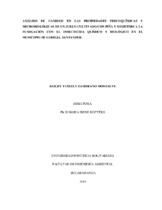Análisis de cambios en las propiedades fisicoquímicas y microbiológicas de un suelo cultivado con piña y sometido a la fumigación con el insecticida químico y biológico en el municipio de Lebrija, Santander

View/
Date
2019-05xmlui.dri2xhtml.METS-1.0.item-advisor
Kopytko, María Irena
xmlui.dri2xhtml.METS-1.0.item-type
Práctica
Citación
Metadata
Show full item recordDocuments PDF
Abstract
El propósito de este proyecto fue analizar los cambios en las propiedades fisicoquímicas y microbiológicas de suelos, cultivados con piña y sometido a la fumigación con insecticida químico y biológico, en el municipio de Lebrija, Santander. Se demostró que los suelos fumigados con insecticidas aportan cambios significantes en algunas de las propiedades fisicoquímicas como el cambio de textura de Franco-arcilloso-arenoso a Franco arenoso del suelo fumigado con insecticida químico. Las propiedades fisicoquímicas iniciales de los suelos de interés presentaron condiciones acidas con bajos valores de pH (4,25 a 4,65) y un nivel de aluminio intercambiable mayor a 1ppm, por lo que puede ejercer la toxicidad en estos suelos. La infiltración entre 175,85 y 397,57 cm/h y la densidad aparente de 1,64 g/cc, se ajusta al valor típico, para estos tipos de suelos agrícolas. Los bajos valores de carbono orgánico total (0,61% a 0,98%) y de la materia orgánica presente en un rango de 1,7% a 3,5%, junto con los bajos valores de nitrógeno total (420 a 476 mg NKT/Kg) señalan la necesidad de una fertilización constante de estos suelos. Los cambios en las características fisicoquímicas de los suelos no afectan notoriamente la distribución poblacional analizada mediante la metagenomica. Los Phylum Actinobacteria, Planctomycetes, Acidobacteria, Verrucomicrobia, Firmicutes, Proteobacteria y Chloroflexi se identificaron como habitantes frecuentes de suelo y sus actividades se asocian a los ciclos biogeoquímicos y degradación de materia orgánica en lo que se presume es una composición típica de suelo cultivado con Ananás comosus. La microbiota descrita en el estudio, permanece durante la aplicación de los insecticidas a pesar de los cambios señalados en las propiedades fisicoquímicas del suelo, lo que sugiere que la prevalencia se deriva de las estructuras de resistencia e interacciones ecológicas dadas al interior de las poblaciones microbianas. The purpose of this project was to analyze the changes in the physicochemical and microbiological properties of soils, cultivated with pineapple and subjected to fumigation with chemical and biological insecticide, in the municipality of Lebrija, Santander. It was demonstrated that the soils fumigated with insecticides contribute with significant changes in some of the physicochemical properties such as the change of texture from clay-loamy-sandy to sandy-loam soil fumigated with chemical insecticide. The initial physicochemical properties of the soils of interest presented acidic conditions with low pH values (4.25 to 4.65) and an exchangeable aluminum level greater than 1 ppm, which can exert toxicity in these soils. The infiltration between 175.85 and 397.57 cm/h and the apparent density of 1.64 g/cc, is adjusted to the typical value for these types of agricultural soils. The low values of total organic carbon (0.61% to 0.98%) and of the organic matter present in a range of 1.7% to 3.5%, together with the low values of total nitrogen (420 to 476 mg NKT/Kg) point out the need for constant fertilization of these soils. The changes in the physicochemical characteristics of the soils do not noticeably affect the population distribution analyzed by metagenomics. The Phylum Actinobacteria, Planctomycetes, Acidobacteria, Verrucomicrobia, Firmicutes, Proteobacteria and Chloroflexi were identified as frequent inhabitants of soil and their activities are associated with the biogeochemical cycles and degradation of organic matter in what is presumed to be a typical composition of soil cultivated with Ananas comosus. The microbiota described in the study remains during the application of the insecticides despite the changes indicated in the physical-chemical properties of the soil, which suggests that the prevalence is derived from the resistance structures and ecological interactions given to the interior of the microbial populations.
Keyword/s
Fisicoquímica
Cultivo de piña
Insecticidas
Lebrija (Santander, Colombia)
Microbiotica
Bioinsecticida
Collections
- Trabajos de grado [6698]
The following license files are associated with this item:

